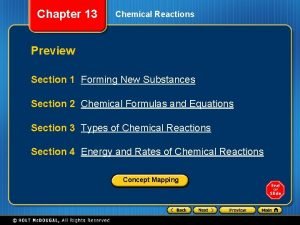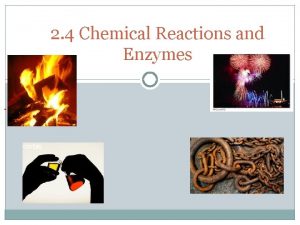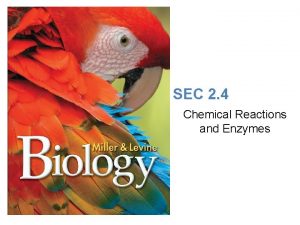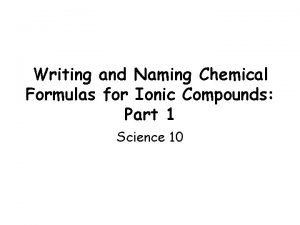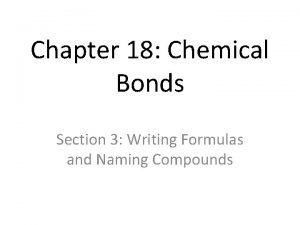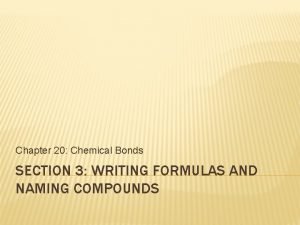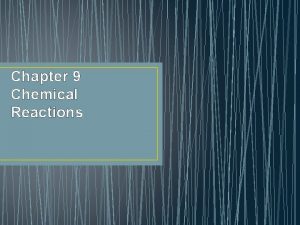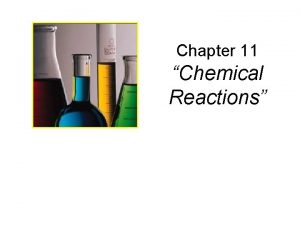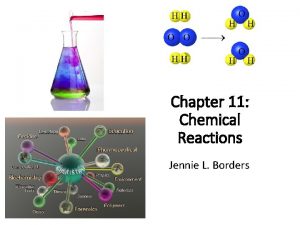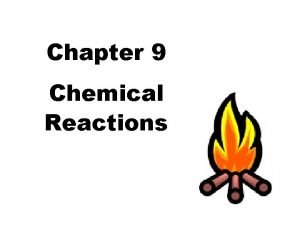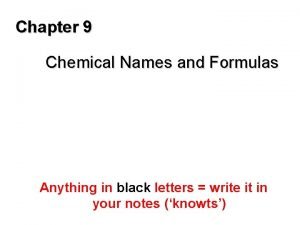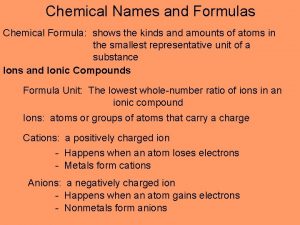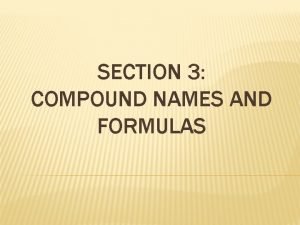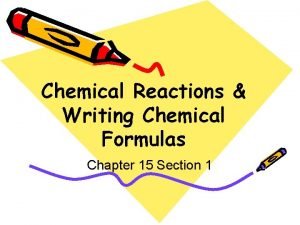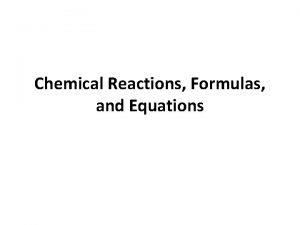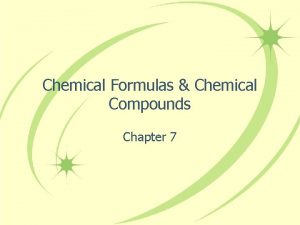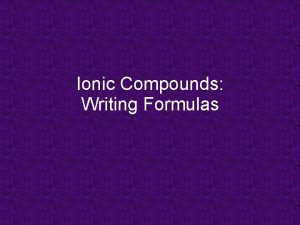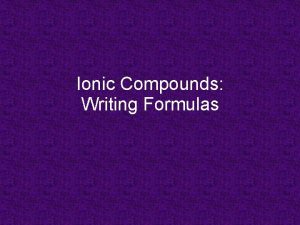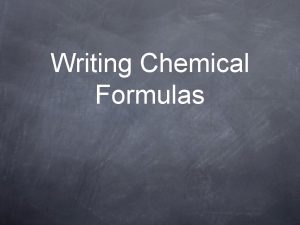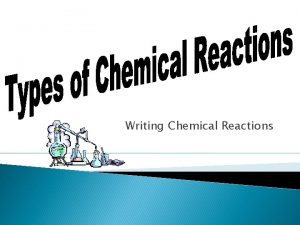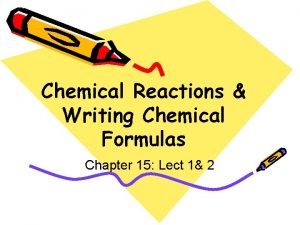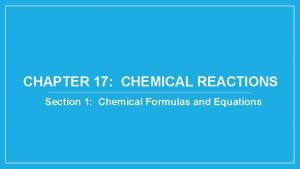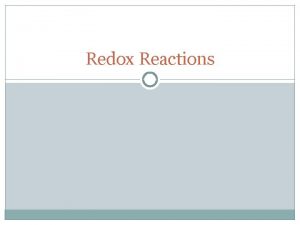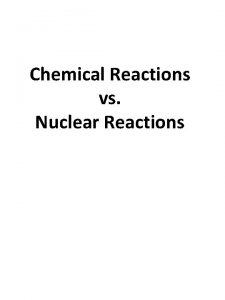Chemical Reactions Writing Chemical Formulas Chapter 15 Section











































- Slides: 43

Chemical Reactions & Writing Chemical Formulas Chapter 15 Section 1

Chemical Change: • Ice melting & water freezing are both examples of physical changes. • During a physical change, a substance changes form, but remains the same substance. • A chemical change turns 1 or more substances into different substances that usually have different properties (they now look different, smell different, act differently, etc. ) • Chemical change is really important & we use it everyday to make necessary substances like rubber, plastic, medicine, etc.

• A chemical reaction is material changing from a beginning mass to a resulting substance. • The conclusion of a chemical reaction is that new material or materials are made, along with the disappearance of the mass that changed to make the new. • This does not mean that new elements have been made. • In order to make new elements, the nuclear contents must change, and that requires major amounts of energy.

So, what is a chemical reaction? • What is a chemical reaction? • A system of chemical changes that involve the breaking & reforming of bonds to create new substances. • The result: a brand new substance

1. Here’s Bill Nye: take notes

Signs of a chemical reaction

1. Bubbles - a gas formed

2. Precipitate - a solid formed

3. Color Change

4. Temperature change energy changed

Parts of a Chemical Reaction • In cooking, ingredients are combined to make food. • In chemical reactions, reactants are combined to make products. • The reactants are substances that are combined & changed in the reaction. • The products are the new substances that result from the reaction.

Example #1: Hydrochloric Acid • Reactants: hydrogen (H 2 - gas) + chlorine (Cl 2 -gas) • The bonds break, the elements rearrange, and form new bonds with each other. • Products: 2 HCl

Example #2: Baking soda & Vinegar • What is the actual reaction between baking soda & vinegar? • Reactants: • Now, break the bonds, rearrange the atoms, and what do you get? ? ? • Products: ADD IT UP: How many total atoms are there? _______ Hydrogen _______ Sodium _______ Oxygen _______ Carbon

ADD IT UP: How many total atoms are there? Na. HCO 3 + HC 2 H 3 O 2 --> Na. C 2 H 3 O 2 + CO 2 + H 20 Reactants: ___5____ Hydrogen ___1___ Sodium ___5____ Oxygen ___3____ Carbon Products: ____5___ Hydrogen ____1___ Sodium ____5___ Oxygen ____3___ Carbon

A chemical reaction rearranges the atoms of the reactants to form new compounds of the products. No new atoms are created

• Chemistry & More Math! • Let’s go back to our first example & add up the atoms from both sides of the equation. • • • Notice that there is the exact same number of each type of atom on both sides of the equation. In other words, the equations are balanced. This proves something VERY important…

The Law of Conservation of Mass: The mass of the reactants equals the mass of the products. OR Mass is never created nor destroyed OR you can’t get somethin’ outta nothin’

Brain. Pop: Conservation of Mass • Click here


2. Law of Conservation of Mass

Chemical Formulas/Equations: • A molecule or compound consists of at least two atoms that are chemically bonded. • The chemical formula of a molecule or compound states how many atoms of each element are in one of its molecules. • This formula is similar to an algebraic formula in its use of symbols. • The description of a compound with numbers and symbols is called a chemical formula. . Some formula can be quite complex.

• A chemical equation is a way to describe what goes on in a chemical reaction, the actual change in a material. • Chemical equations are written with the symbols of materials to include elements, ionic or covalent compounds, aqueous solutions, or particles.

• There is an arrow pointing to the right that indicates the action of the reaction. • The materials to the left of the arrow are the reactants, or materials that are going to react. • The materials to the right of the arrow are the products, or materials that have been produced by the reaction.

Chemical formulas • Chemical formulas are designations of molecules and compounds in shorthand notation, similar to that used in Algebra. • This is a way to show the exact number of atoms & compounds in a chemical reaction. • We write the chemical equation for baking soda & vinegar as follows: • Na. HCO 3 + HC 2 H 3 O 2 ------> Na. C 2 H 3 O 2 + CO 2 + H 2 O

• Click here


EXAMPLES OF CHEMICAL CHANGES shown in chemical formulas: • Chemical reactions, also called chemical changes, are not limited to happening in a chemistry lab. • Here are some examples of chemical reactions with the corresponding chemical equations:

EXAMPLES OF CHEM CHANGES shown in chemical formulas: • 1. A silver spoon tarnishes. The silver reacts with sulfur in the air to make silver sulfide, the black material we call tarnish. • 2 Ag + S --> Ag 2 S • 2. An iron bar rusts. The iron reacts with oxygen in the air to make rust. • 4 Fe + 3 O 2 --> 2 Fe 2 O 3

EXAMPLES OF CHEM CHANGES shown in chemical formulas: • 3. Methane burns. Methane combines with oxygen in the air to make carbon dioxide and water vapor. • CH 4 + 2 O 2 --> CO 2 + 2 H 2 O • 4. An antacid (calcium hydroxide) neutralizes stomach acid (hydrochloric acid). • Ca(OH)2 + 2 HCl --> Ca. Cl 2 + 2 H 2 O

• MORE Chemical Equations Examples • • • Here are some common equations: Water: 2 H 2 + O 2 --> 2 H 2 O Carbon Dioxide: CH 4 + 2 O 2 --> CO 2 + 2 H 2 O Photosynthesis: 6 CO 2 + 6 H 2 O --> C 6 H 12 O 6 + 6 O 2

• Salt: 2 Na + Cl 2 --> 2 Na. Cl • the poisonous green chlorine gas is combined with the explosive metal sodium to form the white salt crystals we use in our food.

Complex formulas • Just as in Algebra, you can use parentheses to separate parts in a complex formula. One example is the formula for nitroglycerin, a highly explosive substance. • C 3 H 5(NO 3)3 • This formula shows that nitroglycerin consists of 3 atoms of C, 5 atoms of H and then 3 NO 3 nitrate ions. If the parentheses were not used, you might have a formula like: • C 3 H 5 N 3 O 9

Complex formulas • The number of atoms for each element would be correct, but it wouldn't help to describe the true structure of the nitroglycerin molecule. • Remember that molecules are 3 dimensional collections of atoms. In more complex molecules--especially in organic substances--the configuration becomes important.

• Carbon dioxide is CO 2, which means there is one atom of carbon and two atoms of oxygen in the molecule.

Number of molecules • To show the number of molecules, a full sized number is located in front of the molecule. • This is called a coefficient. • For example 4 molecules of carbon dioxide is designated as: 4 CO 2 • This means there a total of 4 C atoms and 8 O atoms in the combination. • A way to remember this--taken from Algebra--is to think of it as 4 x (CO 2).

BALANCING EQUATIONS • Now comes the fun part, balancing the reaction. • The Law of Conservation of Mass states that in a chemical reaction there is no loss of mass. • Each type of element will have the same amount before the reaction and after the reaction, or as reactant and product. • But you can’t change the materials that participate in the reaction, so you must write an integer coefficient in front of (to the left of) each material in the reaction to make sure every type of atom has the same number on each side of the reaction.

BALANCING EQUATIONS • 1. Nitrogen gas plus hydrogen gas under pressure and at high temperature turn into ammonia. • First write the materials correctly. Nitrogen and hydrogen are diatomic gases. Ammonia is a binary covalent memory item. • The nitrogen and hydrogen are the reactants, and the ammonia is the product. • Leave room for the coefficients in front of the materials. • _ N 2 + _ H 2 --> _ NH 3

• 2. You can begin with either the nitrogen or the hydrogen. • There are two nitrogen atoms on the left and only one on the right. • In order to balance the nitrogen atoms, place a 2 in front of the ammonia. • _ N 2 + _ H 2 --> 2 NH 3

• 3. There are two hydrogens on the left and six on the right. We balance the hydrogens by placing a 3 in front of the hydrogen gas. • _ N 2 + 3 H 2 --> 2 NH 3

• 4. Now go back and check to make sure everything is balanced. There are 2 nitrogen and 6 hydrogens on both sides of the reaction. It is balanced. • There is no coefficient shown in front of the nitrogen. There is no need to write ones as coefficients. • • The reaction equation is: N 2+ 3 H 2 --> 2 NH 3

THE 4 RULES OF CHEMICAL REACTIONS • 1. Chemical reactions are processes in which atoms are rearranged into different combinations of molecules. • 2. Reactants interact, change bonds, and form products with different chemical properties. • 3. In a reaction, the number of atoms stays the same, no matter how they are arranged, so their total mass stays the same. • 4. Chemical reactions usually liberate/release or absorb heat. (which we will talk about more tomorrow!

In conclusion • The number of atoms of each element in a chemical formula is designated by the small number behind each element symbol. • If there is no number, it is assumed there is only one of that element. • A large number in front of a compound designates how many units there are of that compound. • Parentheses can be used to designate a special structure, where other molecules are attached to the larger, complex molecule.

3. Everybody sing….
 Chemical reactions section 2 classifying chemical reactions
Chemical reactions section 2 classifying chemical reactions Section 2 classifying chemical reactions
Section 2 classifying chemical reactions Chemical reactions section 3 reactions in aqueous solutions
Chemical reactions section 3 reactions in aqueous solutions Section 1 chemical changes
Section 1 chemical changes Are kc and kp equal
Are kc and kp equal Chemical equations and reactions chapter 8 review
Chemical equations and reactions chapter 8 review Chapter 8 section 1 chemical equations and reactions
Chapter 8 section 1 chemical equations and reactions Empirical formula pogil
Empirical formula pogil Modern chemistry chapter 7 review answers
Modern chemistry chapter 7 review answers Chapter 10 chemical reactions
Chapter 10 chemical reactions Chapter 9 chemical reactions study guide
Chapter 9 chemical reactions study guide Representative metal
Representative metal Combination reaction example
Combination reaction example Section 2-4 chemical reactions and enzymes
Section 2-4 chemical reactions and enzymes Chemistry in biology section 2 chemical reactions
Chemistry in biology section 2 chemical reactions Chapter 6 chemistry in biology
Chapter 6 chemistry in biology Section 2 chemical reactions answer key
Section 2 chemical reactions answer key Section 2-4 chemical reactions and enzymes
Section 2-4 chemical reactions and enzymes Section 2-4 chemical reactions and enzymes
Section 2-4 chemical reactions and enzymes Oxidation half reaction
Oxidation half reaction Chemistry unit 5 reactions balancing reactions worksheet
Chemistry unit 5 reactions balancing reactions worksheet Writing and naming chemical formulas
Writing and naming chemical formulas Criss cross method writing formulas
Criss cross method writing formulas Prefixes for hydrates
Prefixes for hydrates Section 3 writing formulas and naming compounds
Section 3 writing formulas and naming compounds Chapter 9 chemical reactions
Chapter 9 chemical reactions Chapter 9 study guide chemical reactions
Chapter 9 study guide chemical reactions Chapter 8 review chemical equations and reactions
Chapter 8 review chemical equations and reactions Chapter 11 chemical reactions answer key
Chapter 11 chemical reactions answer key Predict the products of the following reactions.
Predict the products of the following reactions. Chapter 19 chemical reactions simple word equations
Chapter 19 chemical reactions simple word equations What is the type of reaction
What is the type of reaction What are active metals
What are active metals Chemical names and formulas worksheet chapter 9
Chemical names and formulas worksheet chapter 9 Chapter 9 chemical names and formulas answer key
Chapter 9 chemical names and formulas answer key Hg3p compound name
Hg3p compound name Chapter 6 section 3 compound names and formulas answer key
Chapter 6 section 3 compound names and formulas answer key Stoichiometry mole island diagram
Stoichiometry mole island diagram Hcl and sodium hydrogen carbonate
Hcl and sodium hydrogen carbonate Redox rules
Redox rules Types of reactions
Types of reactions 4 types of chemical reactions
4 types of chemical reactions How to identify type of reaction
How to identify type of reaction Predicting products of chemical reactions
Predicting products of chemical reactions
















